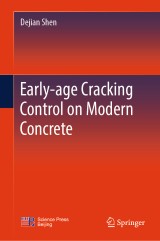Details
Early-age Cracking Control on Modern Concrete
|
171,19 € |
|
| Verlag: | Springer |
| Format: | |
| Veröffentl.: | 26.06.2024 |
| ISBN/EAN: | 9789819714957 |
| Sprache: | englisch |
| Anzahl Seiten: | 250 |
Dieses eBook enthält ein Wasserzeichen.
Beschreibungen
<p>This monograph is written based on the author's extensive research over the last decade on the assessment and control of cracking of early-age concrete. The technique of crack control of modern concrete at early age is further developed through experimental and theoretical research, such as mitigating the drop of IRH, controlling the hydration process, decreasing the shrinkage, and increasing the tensile strength. It indicates the innovative findings and establishes prediction models on early-age internal relative humidity, autogenous shrinkage, tensile creep of modern concrete considering water-to-cement ratio, curing temperature., etc; reveals the variation law and mechanism of early-age cracking resistance of modern concrete with different kinds of fibers, supplementary cementitious materials, chemical admixtures, and internal curing agents under circumferential or uniaxial restrained condition. It is designed as a reference work for professionals or practitioners and a textbookfor undergraduates or postgraduates.</p>
<p> </p><br><p></p>
<p> </p><br><p></p>
<p>Introduction.- Techniques and methods for evaluating the early-age cracking resistance of modern concrete.- Evaluation on early-age cracking resistance of concrete.- Early-age cracking control on concrete with fly ash.- Early-age cracking control on concrete with ground granulated blast furnace slag.- Early-age cracking control on concrete with silica fume.- Early-age cracking control on concrete with 3D hooked-end steel fiber.- Early-age cracking control on concrete with 5D hooked-end steel fiber.- Early-age cracking control on concrete with polypropylene fiber.- Early-age cracking control on high strength concrete with polyvinyl alcohol fibers.- Early-age cracking control on high strength concrete with Nano-CaCO3.- Early-age cracking control on high strength concrete with crystalline admixture.- Early-age cracking control on concrete with MgO compound expansive agent.- Early-age cracking control on concrete with temperature rise inhibitor.- Early-age cracking control on high strength concrete with shrinkage reducing admixture.- Early-age cracking control on concrete with reinforcing bars.- Early-age cracking control on concrete with internal curing.<br></p>
<p>Dejian Shen is a professor at the College of Civil and Transportation Engineering, Hohai University. He has published 4 monograph, more than 170 papers including over 100 SCI-indexed papers (9 ESI highly cited papers and 2 ESI hot paper), and more than 90 patents.</p>
<p>His research interests include:</p>
<p>• Assessment, control, and repair of early-age cracks in reinforced concrete structures</p>
<p>• Seismic performance and design method for prefabricated construction</p>
<p>• FRP technology for repairing damaged and corroded reinforced concrete structures</p>
<p>• Quantum chemical simulation, molecular dynamics simulation and multiscale simulation for concrete.</p><br>
<p>His research interests include:</p>
<p>• Assessment, control, and repair of early-age cracks in reinforced concrete structures</p>
<p>• Seismic performance and design method for prefabricated construction</p>
<p>• FRP technology for repairing damaged and corroded reinforced concrete structures</p>
<p>• Quantum chemical simulation, molecular dynamics simulation and multiscale simulation for concrete.</p><br>
<p>This monograph is written based on the author's extensive research over the last decade on the assessment and control of cracking of early-age concrete. The technique of crack control of modern concrete at early age is further developed through experimental and theoretical research, such as mitigating the drop of IRH, controlling the hydration process, decreasing the shrinkage, and increasing the tensile strength. It indicates the innovative findings and establishes prediction models on early-age internal relative humidity, autogenous shrinkage, tensile creep of modern concrete considering water-to-cement ratio, curing temperature., etc; reveals the variation law and mechanism of early-age cracking resistance of modern concrete with different kinds of fibers, supplementary cementitious materials, chemical admixtures, and internal curing agents under circumferential or uniaxial restrained condition. It is designed as a reference work for professionals or practitioners and a textbook for undergraduates or postgraduates.</p>
<p> </p>
<p> </p>
Clarifies the cracking resistance of concrete under circumferential or uniaxial restrained conditions Introduces several methods for cracking control of modern concrete Numerous test results based on the author's research results of the recent 10 years
Diese Produkte könnten Sie auch interessieren:

Water Quality Hazards and Dispersion of Pollutants

von: Wlodzimierz Czernuszenko, Pawel Rowinski

149,79 €
















